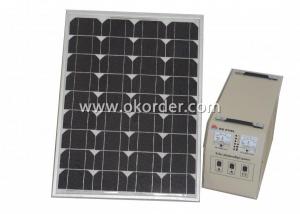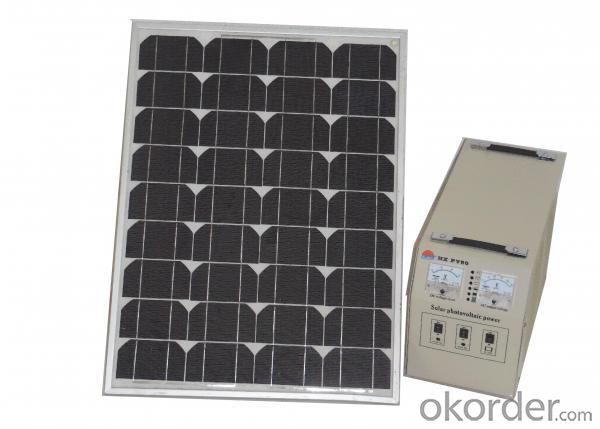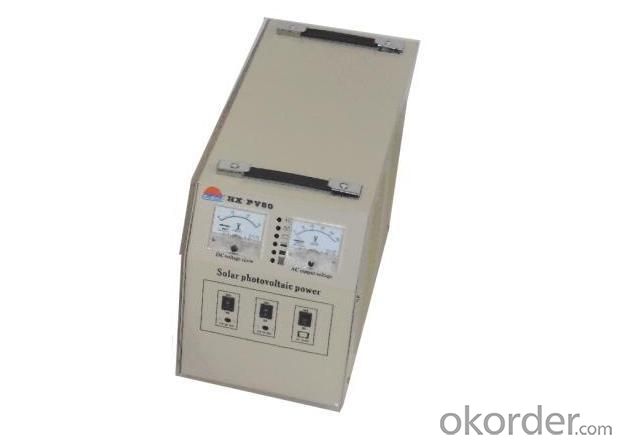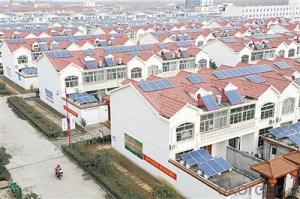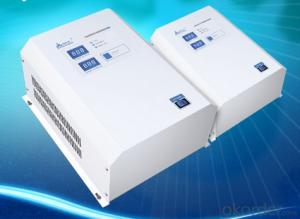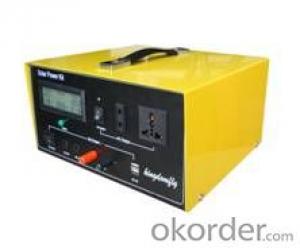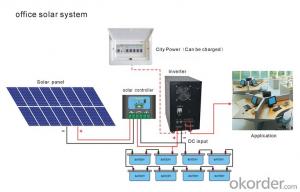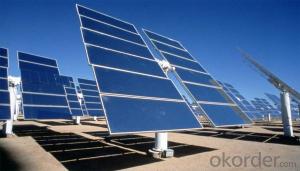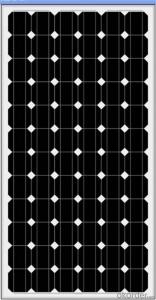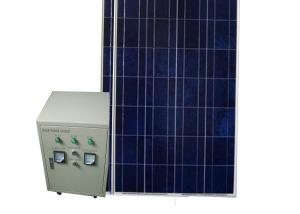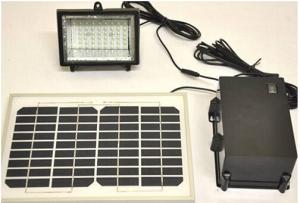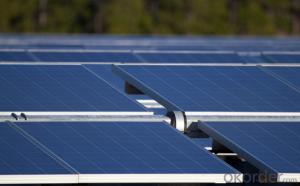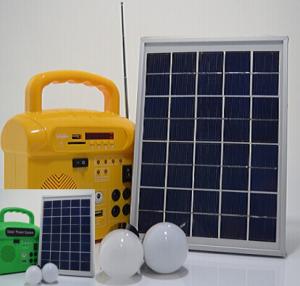Sunspot Solar Energy Systems CNBM-K1 (60W) Solar Home System
- Loading Port:
- China Main Port
- Payment Terms:
- TT or L/C
- Min Order Qty:
- 1 set set
- Supply Capability:
- 1000 sets per month set/month
OKorder Service Pledge
OKorder Financial Service
You Might Also Like
Brief Introduction of Solar Home System CNBM-K1 (60W)
CNBM Home System-K1 (60W) has a wonderful capacity.It can be used in factory,home,school and other CNBM Home System-K1 60W consist of the solar modules,charge controller,inverter and battery banks.
CNBM International is highly recognized by its business partners and clients all over the world and has obtained rapid development under the spirit of win-win .
With CNBM Home System-K1 (60W),
We will carry on the mutual beneficial,innovative and revolutionary trading structure as we did before,create value for our employees,share holders and clients and benefit the whole society in our future development.Please contact us ,if you have interest in CNBM Home
System-K1 (60W),don’t hesitate!
The Sketching of Solar Home System CNBM-K1 (60W)
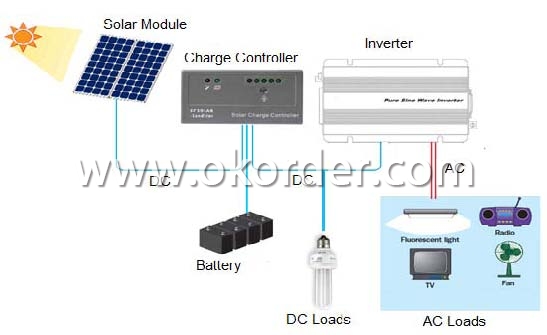
Components of Solar Home System CNBM-K1 (60W)
PV Array:
Convert sunlight instantly into DC electric power. Formed by the solar modules (also called photovoltaic modules) in accordance with the system requirements for series and parallel.
Solar Charge Controller:
A charge controller may be used to power DC equipment with solar panels. The charge controller provides a regulated DC output and stores excess energy in a battery as well as monitoring the battery voltage to prevent over charge or over discharge. An inverter can be connected to the output of a charge controller to drive AC loads.
Inverter:
Converts DC output power of photovaltaic soalr panels into standard AC power for use in the local off-grid electrical network. It is a critical component in a photovoltaic system, allowing the use of ordinary commercial appliances.
Battery banks:
Stores energy when there is an excess coming in and distribute it back out when there is a demand. Solar PV panels continue to re-charge batteries each day to maintain battery charge.
Technical data of Solar Home System CNBM-K1 (60W) | ||
Inverter | Rated load power | 500W |
Output wave | Modify sine wave | |
Output voltage | DC 12V | |
Output frequency | DC:12V AC:220V | |
Precision of output | 50HZ/60HZ | |
Precision of output frequency | ±6% | |
Solar panel | Pmax | 60W |
Vmp | 18.4V | |
Imp | 3.26A | |
Charger | Charger voltage & current | 12V 10A |
Battery | Capacity | 12V 30AH |
Power box | Spray paint iron box,with input,output,ammeter,voltmeter,master swith and so on. | |
Package of Solar Home System CNBM-K1 (60W) | ||||
Part | Size(L*W*H mm) | Weight(kg) | 20’(pcs) | 40’(pcs) |
Power box | 520*220*430 | 35 | 140 Sets | 320 Sets |
Solar panel | 630*670*30 | 6 | ||
Battery | 190*130*160 | 12 | ||
Factory Picture of Solar Home System CNBM-K1 (60W)
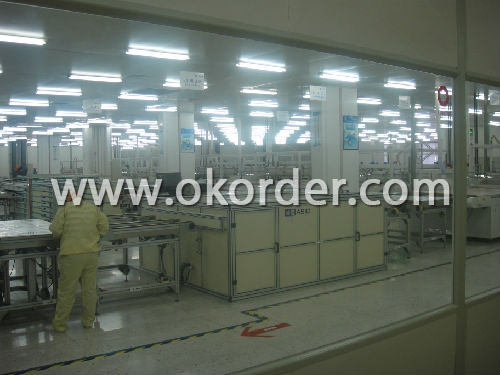
Package Picture of Solar Home System CNBM-K1 (60W)
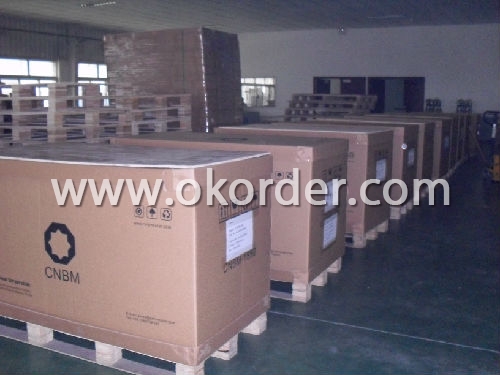
- Q: Solar photovoltaic system
- State subsidies for distributed PV policy: distributed generation price subsidies by 0.42 yuan / kWh (subsidies for a period of 20 years), distributed photovoltaic power generation system of power grid, power grid enterprises in accordance with the local coal-fired power by electricity (0.44 yuan /kWh) acquisition.
- Q: Can solar energy systems be used in powering beauty salons or spas?
- Yes, solar energy systems can definitely be used to power beauty salons or spas. Solar energy is a renewable and sustainable source of power that can help reduce the dependence on grid electricity and minimize the carbon footprint of these establishments. By installing solar panels on the roof or other suitable areas, beauty salons and spas can generate their own electricity and reduce their energy costs in the long run. Beauty salons and spas typically require a significant amount of electricity to operate hair dryers, hair straighteners, curling irons, lighting, air conditioning, and other equipment. Solar energy systems can easily meet these power demands, especially during daylight hours when the sun is shining. Excess electricity generated during the day can be stored in batteries or fed back into the grid, ensuring a continuous supply of power at all times. Moreover, solar energy systems can help improve the sustainability and environmental performance of beauty salons and spas. By switching to solar power, these establishments can significantly reduce their carbon emissions and contribute to the fight against climate change. Additionally, using solar energy can help attract environmentally conscious customers who appreciate businesses that prioritize sustainability. In summary, solar energy systems are a viable option for powering beauty salons and spas. They can provide a reliable and sustainable source of electricity, reduce energy costs, and contribute to a greener and more environmentally friendly business operation.
- Q: What is the difference between a grid-tied and off-grid solar energy system?
- A grid-tied solar energy system is connected to the local utility grid, allowing excess electricity generated by the solar panels to be fed back into the grid. This system typically does not require batteries, as any shortfall in electricity can be supplemented from the grid. On the other hand, an off-grid solar energy system operates independently from the utility grid and relies on battery storage to store excess electricity for use during times when the panels are not producing enough power, such as at night or during cloudy days.
- Q: Are there any tax credits available for installing a solar energy system?
- Yes, there are tax credits available for installing a solar energy system. The federal government offers a Solar Investment Tax Credit (ITC) which allows homeowners and businesses to deduct a percentage of the cost of installing a solar energy system from their federal taxes. As of 2021, the ITC offers a 26% tax credit for systems installed through the end of 2022. However, it is important to note that the tax credit will decrease to 22% in 2023 and will only apply to commercial installations. Additionally, some states also offer their own tax incentives for solar energy systems, such as tax credits, rebates, or exemptions. It is recommended to check with your state or local government to determine if there are any specific tax credits available in your area.
- Q: Can solar energy systems be used in areas with limited water resources?
- Yes, solar energy systems can be used in areas with limited water resources. Solar energy systems primarily rely on the sun's radiation to produce electricity or heat, and do not require significant amounts of water for operation. Unlike conventional power plants that rely on water for cooling and steam generation, solar energy systems can operate without the need for water-intensive processes. Solar photovoltaic (PV) systems, which convert sunlight directly into electricity, do not require water for operation. These systems consist of solar panels that capture sunlight and convert it into electricity through the photovoltaic effect. As a result, they can be installed in areas with limited water resources without any impact on their functionality. Solar thermal systems, on the other hand, use sunlight to heat a fluid, such as water or oil, which is then used to generate electricity or provide heating. While these systems may require some water for cleaning or maintenance purposes, the water requirements are relatively minimal compared to traditional power plants. Additionally, advancements in solar thermal technology have led to the development of dry-cooling systems, which significantly reduce water consumption. Moreover, solar energy systems can be combined with other technologies to further minimize water usage. For instance, solar-powered desalination plants can be used to convert seawater or brackish water into freshwater through a process called reverse osmosis, without relying on traditional energy sources or fossil fuels. This integration of solar energy and desalination can provide clean drinking water in areas with limited freshwater resources, while reducing the strain on water supplies. In conclusion, solar energy systems are well-suited for areas with limited water resources as they operate primarily on sunlight and do not require significant amounts of water for their functioning. The use of solar power can not only reduce greenhouse gas emissions and dependence on fossil fuels but also alleviate the water scarcity issues faced by these regions.
- Q: Can solar energy systems be used in areas with high levels of humidity?
- Yes, solar energy systems can be used in areas with high levels of humidity. While humidity can affect the overall efficiency of solar panels, modern solar technology is designed to withstand a wide range of environmental conditions, including high humidity. The key factor in determining the suitability of solar energy systems in humid areas is the proper maintenance and installation of the equipment. Regular cleaning and maintenance of solar panels can help mitigate any potential issues caused by humidity, such as dust or dirt buildup. Additionally, advancements in solar panel technology have made them more resistant to moisture and humidity, ensuring their durability and longevity even in humid areas. Therefore, solar energy systems can be effectively utilized in areas with high levels of humidity, providing a clean and renewable source of energy.
- Q: Are there any limitations to using solar energy for powering vehicles?
- Yes, there are some limitations to using solar energy for powering vehicles. The main limitation is the limited amount of energy that can be harvested from the sun, especially when compared to the energy density of conventional fossil fuels. Additionally, solar panels require a large surface area for installation, which could be a challenge for vehicles with limited space. Moreover, solar energy is intermittent, meaning it is not available during the night or in cloudy weather, which might affect the reliability and range of solar-powered vehicles. Finally, the cost of solar panels and their relatively low efficiency in converting sunlight to electricity also pose challenges to widespread adoption. Nonetheless, advancements in technology and the development of energy storage solutions are helping to overcome some of these limitations and make solar-powered vehicles more viable.
- Q: Can solar energy systems be used in powering outdoor signage or billboards?
- Indeed, outdoor signage or billboards can be powered by solar energy systems. By placing solar panels on the roof or nearby structures, sunlight can be captured and transformed into electricity. This generated electricity is then employed to illuminate the lights or operate the digital displays of the signage or billboards, enabling them to function autonomously without relying on the conventional power grid. Given their prevalence in sun-drenched areas, solar energy systems are especially well-suited for outdoor signage. Moreover, utilizing solar energy aids in mitigating the carbon footprint linked to traditional methods of electricity production, rendering it an eco-friendly alternative.
- Q: What government incentives are available for solar energy systems?
- There are several government incentives available for solar energy systems. These include federal tax credits, state and local rebates, grants, and loan programs. Additionally, some utility companies offer net metering programs that allow solar system owners to earn credits for excess electricity they generate. These incentives aim to encourage the adoption of solar energy and make it more affordable for individuals and businesses to install solar systems.
- Q: Can solar energy systems be used in powering amusement parks?
- Yes, solar energy systems can be used to power amusement parks. Solar panels can be installed on the roofs of buildings, parking structures, or in open spaces within the park to generate electricity from the sun. This renewable energy source can help reduce the park's reliance on traditional grid power, lower operating costs, and decrease its carbon footprint. Additionally, solar energy systems can provide a reliable and consistent source of power, making them suitable for meeting the electrical demands of amusement parks.
Send your message to us
Sunspot Solar Energy Systems CNBM-K1 (60W) Solar Home System
- Loading Port:
- China Main Port
- Payment Terms:
- TT or L/C
- Min Order Qty:
- 1 set set
- Supply Capability:
- 1000 sets per month set/month
OKorder Service Pledge
OKorder Financial Service
Similar products
Hot products
Hot Searches
Related keywords
